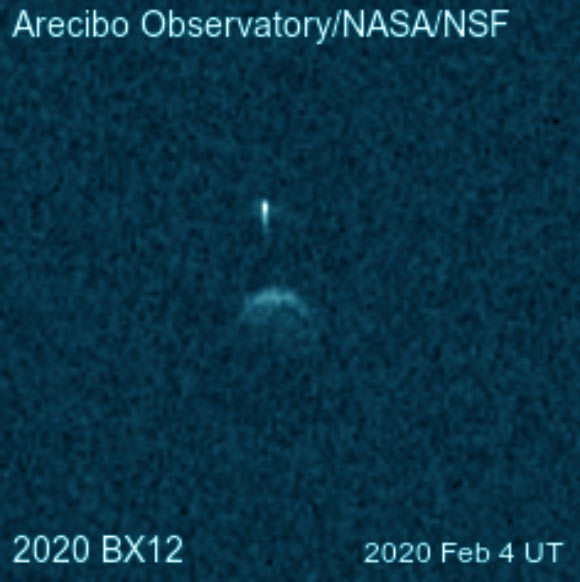Arecibo Observatory Reveals Near-Earth Asteroid 2020 BX12 Has Large Moon | Astronomy – Sci-News.com
Astronomers using a radio telescope at the Arecibo Observatory have captured the first images of the recently-discovered near-Earth asteroid 2020 BX12. The radar images show 2020 BX12 has its own moon.

Range-Doppler radar image (colorized) of the binary near-Earth asteroid 2020 BX12. Image credit: Arecibo Observatory.
Discovered on January 27, 2020 by the ATLAS survey, 2020 BX12 is a round object at least 165 m (541 feet) in diameter rotating approximately once every 2.8 hours or less.
This object fits the definition of a potentially hazardous asteroid due to its size and minimum orbit intersection distance of 302,000 km (188,000 miles) from the Earth.
While this means it could conceivably come closer to the Earth than the Moon, the asteroid poses no danger at this time and is currently receding from Earth.
Dr. Luisa Fernanda Zambrano-Marín and her colleagues at the Arecibo Observatory observed 2020 BX12 on February 4 and 5, 2020.
The radar images revealed that the object has a large satellite, which has a diameter of approximately 70 m (230 feet) and rotates once every 49 hours or less. The distance between the two bodies is at least 360 m (1,181 feet).
“The movement of 2020 BX12’s satellite between the two observations, which were made 23 hours apart, suggests a mutual orbital period of 45-50 hours and would be consistent with a tidally locked satellite,” the astronomers said.
“Due to projection effects, uncertainties remain on the rotation periods, and a shorter mutual orbital period of 15-16 hours has not yet been ruled out.”
“The secondary appears brighter than the primary body in the radar images, which is common for radar images of binaries.”
“The horizontal axis in delay-Doppler images shows, in fact, the echo power per Doppler-shifted frequency, or in other words the surface area that has a specific radial velocity relative to the observer.”
“This makes objects that rotate slower appear narrower in delay-Doppler images than objects that rotate faster.”
“Because the secondary body rotates much slower than the primary, its echo power is distributed to fewer Doppler frequency bins than the echo power from the primary body, making the amount of echo power per pixel appear more intense.”






